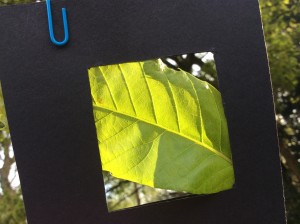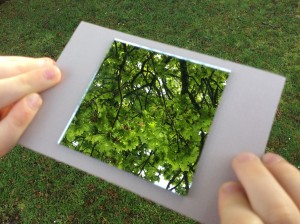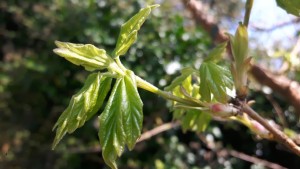Just a few weeks ago our woodlands and hedgerows appeared barren but now there is an explosion of new life and colour. How does this happen?
Dormant buds, which will become this year’s leaves and flowers, were grown last summer and protected through the winter within thick overlapping bud scales. Triggered by increasing day length and warmth, buds begin to swell, burst open and new leaves unfurl. Elder tree buds are the first to open followed by hawthorn. It’s an exciting time waiting for the next trees to leaf. I love the large sticky horse chestnut buds and the soft bright lime green leaves of the beech tree.
Here are some fun activity challenges to celebrate leaves and the cycle of new growth each spring:
Up close and personal: Give each student a tree leaf to look at and study. Demonstrate how to use a hand lens to look at the unique characteristics of their leaf. Point out the variety of shapes, sizes and textures. Young beech leaves feel soft and delicate with hairy edges, and hazel leaves feel fuzzy. Invite the group to share their learning by asking them to hold up their leaves if they have: smooth or toothed edges; feel fuzzy; have a long or short stem; feel waxy (oak leaves) etc.
Leaf jumble: Now invite everyone to put their leaf in a ‘leaf viewer’ and hold them up towards the sunlight to view its intricate veins and colour. What makes your leaf special? Then gather in, jumble up and lay all the leaves out on the ground – can they find their leaf again?

Colour matching: There are many shades of leaf green. Using a selection of green colour paint cards (visit your local DIY store) challenge everyone to take out a card from a ‘luck dip bag’ and to match that shade of green as closely as possible to a plant or tree leaf (remember to set your boundaries). For older groups they could be encouraged to use tree guides with simple keys to identify their match, developing further their knowledge about identification features. The tree name trail (FSC) is an excellent guide.
Canopy reflections: Give each pair a small hand-held mirror, which they need to hold with both hands at nose level. Ask their partner to guide them carefully under a large tree. When they look down into the mirror they will see the tree canopy reflected above – it’s magical, giving a different perspective of the world!

Canvas leaf prints: Young fresh leaves are full of a green pigment called chlorophyll – it’s how these ‘great producers’ make their own food (energy) using a process called photosynthesis. To capture the shape, colour and detail of leaves, simply put a leaf between a folded square of calico or white cotton sheet and hammer over the surface using a small wooden mallet – you’ll see the green pigment start to stain through the cloth. Then open out to reveal your print.
Eat your spring greens: Whilst still young, collect beech and hawthorn leaves. These can be eaten straight from the tree or in a salad. This is a good introduction to foraging wild foods through the seasons and developing identification skills. Make sure that you identify them correctly, seek advice if unsure.

